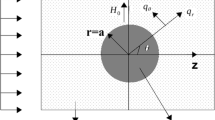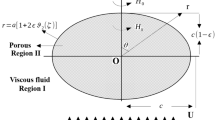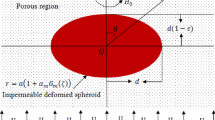Abstract
The current work deals with the Stokes incompressible flow past an impermeable spheroidal particle, a particle of slightly deformed spherical shape, implanted in a Brinkman’s porous media. The problem is perused by considering the slip flow boundary conditions at the interface. An analytical result for the drag force affecting on the spheroid is evaluated. Both the cases of an oblate and a prolate spheroids are analyzed. Dependence of drag coefficient in relation to different important dimensionless parameters including permeability, deformation, and slip are visualized using graphs and tables. The effect of slip is observed to have a remarkable impact in raising the drag. Several notable results are derived from the ongoing work.





Similar content being viewed by others
References
Darcy, H.P.G.: Les fontaines publiques de la ville de dijon. Victor Delmont, Paris (1856)
Brinkman, H.C.: A calculation of the viscous force exerted by a flowing fluid on a dense swarm of particles. Appl. Sci. Res. A1(1), 27–34 (1949)
Padmavathi, B.S., Amarnath, T., Palaniappan, D.: Stokes flow about a porous spherical particle. Arch. Mech. 46, 191–199 (1994)
Bhupen, B.: Flow of a Newtonian fluid past an impervious sphere embedded in a porous medium. Indian J. Pure Appl. Math. 27(12), 1249–1256 (1996)
Pop, I., Ingham, D.B.: Flow past a sphere embedded in a porous medium based on Brinkman model. Int. Comm. Heat Mass Trans. 23(6), 865–874 (1996)
Rudraiah. N., Shivakumara, I.S., Palaniappan, D., Chandrasekhar, D.V.: Flow past an impervious sphere embedded in a porous medium based on non Darcy model. In: Proc Seventh Asian Cong Fluid Mech. 565–568 (1997)
Feng, J., Ganatos, P., Weinbaums, S.: Motion of a sphere near planar confining boundaries in a Brinkman medium new block. J. Fluid Mech. 375, 265 (1998)
Srinivasacharya, D., Ramana Murthy, J.V.: Flow past an axisymmetric body embedded in a saturated porous media. C. R. Mecanique 330, 417–423 (2002)
Rudraiah, N., Chandrashekhar, D.V.: Flow past an impermeable sphere embedded in a porous medium with Brinkman model. Int. J. Appl. Mech. Eng. 10, 145–158 (2005)
Kohr, M., Raja Sekar, G.P.: Existence and uniqueness result for two-dimensional porous media flows with porous inclusions based on Brinkman equation. Eng. Anal. Boundary Elem. 31(7), 604–613 (2007)
Pal, D., Mondal, H.: Radiation effects on combined convection over a vertical flat plate embedded in a porous medium of variable porosity. Meccanica 44(2), 133–144 (2009)
Wang, C.Y.: Darcy-Brinkman flow with solid inclusions. Chem. Eng. Commun. 197, 261–274 (2010)
Grosan, T., Postelnicu, A., Pop, I.: Brinkman flow of a viscous fluid through a spherical porous medium embedded in another porous medium. Transp. Porous Med. 81, 89–103 (2010)
Deo, S., Gupta, B.R.: Drag on a porous sphere embedded in another porous medium. J. Porous Media 13(11), 1009–1016 (2010)
Saxena, P., Kumar, L.: Flow of viscous fluid through different porous structures embedded in porous medium. J. Porous Media. 15(12), 1125–1135 (2012)
Leontev, N.E.: Flow past a cylinder and a sphere in a porous medium within the framework of the Brinkman equation with the Navier boundary condition. Fluid Dyn. 49(2), 232–237 (2014)
Prasad, M.K., Srinivasacharya, D.: Micropolar fluid flow through a cylinder and a sphere embedded in a porous medium. Int. J. Fluid Mech. Res. 44(3), 229–240 (2017)
Ansari, I.A., Deo, S.: Magnetohydrodynamic viscous fluid flow past a porous sphere embedded in another porous media. Spec. Top. Rev. Porous Media Int. J. 9(2), 191–200 (2018)
Shreen, El-Sapa., Saad, E.I., Faltas, M.S.: Axisymmetric motion of two spherical particles in a Brinkman medium with slip surfaces. Eur. J. Mech. B/Fluids. 67, 306–313 (2018)
Krishnan, R., Shukla, P.: Drag on a fluid sphere embedded in a porous medium with solid core. Int. J. Fluid Mech. Res. 46(3), 219–228 (2019)
Prasad, M.K., Bucha, T.: MHD on a cylinder implanted in a porous media of micropolar fluid. J. Theoretical Appl. Mech., Sofia. 50(4), 307–320 (2020)
Prasad, M.K., Bucha, T.: Influence of MHD on micropolar fluid flow past a sphere implanted in porous media. Ind. J. Phys. 95(6), 1175–1183 (2021)
Acrivos, A., Taylor, T.D.: The Stokes flow past an arbitrary particle: the slightly deformed sphere. Chem. Eng. Sci. 19, 445–451 (1964)
Oberbeck, A., Stationare, U.: Fliissigkeitsbewegungen mit Berucksichtigung der inneren Reibung. J. Reine Angew. Math. 81, 62–80 (1876)
Sampson, R.A.: On Stoke’s current function. Phil. Trans. R. Soc. Lond. A. 182, 449–518 (1891)
Ramkissoon, H: Stokes flow past a slightly deformed fluid sphere, Z. Angew. Math. Phys. 37, 859–866 (1986)
Palaniappan, D.: Creeping flow about a slightly deformed sphere. Z. Angew. Math. Phys. 45, 832–838 (1994)
Dassios, G., Hadjinicolaou, M., Coutelieris, F.A., Payatakes, A.C.: Stokes flow in spheroidal particle-in-cell models with Happel and Kuwabara boundary conditions. Int. J. Eng. Sci. 33(10), 1465–1490 (1995)
Ramkissoon, H.: Slip flow past an approximate spheroid. Acta Mech. 123, 227–233 (1997)
Zlatanovski, T.: Axi-symmetric creeping flow past a porous prolate spheroidal particle using the Brinkman model. Q. J. Mech. Appl. Math. 52(1), 111–126 (1999)
Deo, S., Datta, S.: Slip flow past a prolate spheroid. Indian J. Pure Appl. Math. 33(6), 903–909 (2002)
Srinivasacharya, D.: Creeping flow past a porous approximate sphere. Z. Angew. Math. Mech. 83(7), 499–504 (2003)
Senchenko, S., Keh, H.J.: Slipping Stokes flow around a slightly deformed sphere. Phys. Fluids. 18(8), 088104 (2006)
Srinivasacharya, D.: Flow past a porous approximate spherical shell. Z. Angew. Math. Phys. 58, 646–658 (2007)
Deo, S.: Stokes flow past a swarm of deformed porous spheroidal particles with Happel boundary condition. J. Porous Media 12(4), 347–359 (2009)
Chang, Y.C., Keh, H.J.: Translation and rotation of slightly deformed colloidal spheres experiencing slip. J. Colloid Interface Sci. 330, 201–210 (2009)
Saad, E.I.: Translation and rotation of a porous spheroid in a spheroidal container. Can. J. Phys. 88, 689–700 (2010)
Saad, E.I.: Stokes flow past an assemblage of axisymmetric porous spheroidal particle in cell models. J. Porous Media. 15(9), 849–866 (2012)
Yadav, P.K., Deo, S.: Stokes flow past a porous spheroid embedded in another porous medium. Meccanica 47, 1499–1516 (2012)
Sherief, H.H., Faltas, M.S., Saad, E.I.: Slip at the surface of an oscillating spheroidal particle in a micropolar fluid. ANZIAM J. 55(E), E1–E50 (2013)
Srinivasacharya, D., Prasad, M.K.: Axisymmetric creeping motion of a porous approximate sphere with an impermeable core. Eur. Phys. J. Plus. 128, 9 (2013)
Yadav, P.K., Tiwari, A., Singh, P.: Hydrodynamic permeability of a membrane built up by spheroidal particles covered by porous layer. Acta Mech. 229, 1869–1892 (2018)
Prasad, M.K., Bucha, T.: Steady viscous flow around a permeable spheroidal particle. Int. J. Appl. Comput. Math. 5, 109 (2019)
Happel, J., Brenner, H.: Low Reynolds number hydrodynamics. Nijhoff, The Hague (1983)
Navier, C.L.M.H.: Memoirs de l’Academie Royale des Sciences de l’Institut de France 1, 414–416 (1823)
Sherief, H.H., Faltas, M.S., Shreen, El-Sapa.: Slow motion of a slightly deformed spherical droplet in a microstretch fluid. Microsystem Technologies 24(8), 3245–3259 (2018)
Author information
Authors and Affiliations
Corresponding author
Ethics declarations
Conflict of interest
The author declare that there is no conflict of interest.
Additional information
Publisher's Note
Springer Nature remains neutral with regard to jurisdictional claims in published maps and institutional affiliations.
A Appendix
A Appendix
Applying the boundary conditions (14)-(15) to the first order in \(\beta _{m}\), we obtain the following system of algebraic equations
\(S_{1}=K_{1/2}(\alpha )\) \(S_{2}=K_{3/2}(\alpha )\)
\(S_{3}=K_{n-1/2}(\alpha )\) \(S_{4}=K_{n-3/2}(\alpha )\)
\(w_{1}=S_{2}+\alpha \,S_{1}\) \(w_{2}=3\,S_{2}+\alpha \,S_{1}\)
On solving the leading terms of equations (A.1)-(A.2) we will get the values of \(a_{2}\) and \(b_{2}\). Since the expressions are very lengthy we are not presenting it here. To obtain the remaining arbitrary constants \(A_{n}\) and \(B_{n}\) we require the following identities
Using these in (A.1) and (A.2), we get \(A_{n}=0\) and \(B_{n}=0\), for \(n\ne m-2, m, m+2\)
and when \(n=m-2, m, m+2\), we have the following system
Rights and permissions
About this article
Cite this article
Madasu, K. ., Kaur, M. & Bucha, T. Slow Motion Past a Spheroid Implanted in a Brinkman Medium : Slip Condition. Int. J. Appl. Comput. Math 7, 162 (2021). https://doi.org/10.1007/s40819-021-01104-4
Accepted:
Published:
DOI: https://doi.org/10.1007/s40819-021-01104-4




